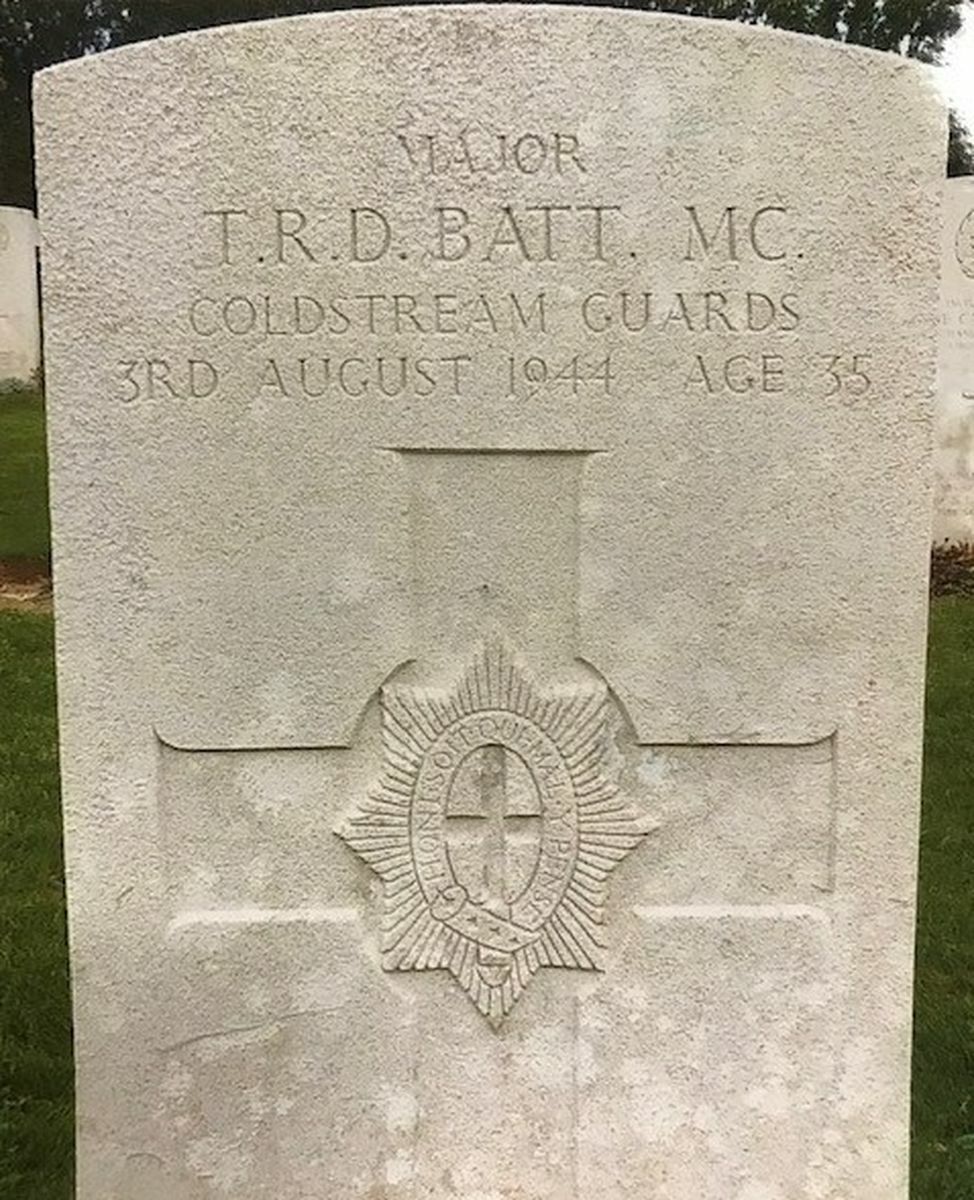Auction: 23003 - Orders, Decorations and Medals
Lot: 272
A 1940 'Dunkirk Mole' M.C. group of seven awarded to Major T. R. D. Batt, Coldstream Guards, who was killed by a sniper on 3 August 1944 whilst serving with the 1st Armoured Battalion
Military Cross, G.VI.R., reverse officially dated '1940'; General Service 1918-62, 1 clasp, Palestine (Lieut. T. R. D. Batt. C. Gds.); 1939-45 Star; France and Germany Star; Defence and War Medal 1939-45; Coronation 1937, good very fine (7)
M.C. London Gazette 27 August 1940. The original Recommendation states:
'For conspicuous gallantry and devotion to duty in May and June 40 throughout the withdrawal from the R. DYLE, especially on the night of 2/3 June 40, when he helped to organise the withdrawal of the last remaining British troops on the beaches at DUNKIRK with such skill that the final evacuation was carried out almost without loss. Captain Batt remained on the Mole to the last directing traffic with a megaphone and setting a magnificent example of calmness and courage.'
Thomas Reginald Dumaresq Batt was born on 28 August 1909, and was the son of Colonel R. C. Batt C.B.E., M.V.O., and his wife Violet who lived at Gresham Hall, Norwich. The younger Batt was educated at Winchester and was a prefect in his final year and also proving an inspiring commander of the House Platoon. He was an avid sportman and played cricket and football, being a member of the House XI which won the Turner Cup in 1927.
Attending the Royal Military Academy Sandhurst, he was a Prize Cadet and won the Riding Prize, later being commissioned 2nd Lieutenant into the Coldstream Guards on 29 August 1929. Appointed A.D.C. to the Governor of Madras on 1 April 1932 this was followed with a promoted to Lieutenant on 29 August 1932. Leaving the role of A.D.C. on 10 February 1935 he served as Adjutant 11 March 1937, being promoted Captain on 1 August 1938.
Posted to to France as part of the British Expeditionary Force he was present with his unit for the Fall of France. After the withdrawal to Dunkirk Batt proved instrumental in organising the evacuation from the Mole. Advanced Major on 4 January 1941 he received the appointments of Brigade Major and later Deputy Assistant Adjutant General to the Guards Armoured Division. Following this with a period as General Staff Officer 2 and Lieutenant-Colonel Assistant Quartermaster General to VIII Corps.
Remaining in Britain until the Normandy invasion Batt reverted to the rank of Major as a Squadron Commander in the 1st Armoured Battalion, Coldstream Guards. He arrived in Normandy between 29 June and 1 July 1944 and spent two weeks acclimatising.
The unit received orders on the 18 July to move their Sherman tanks and set off for the Orme bridge with 1 Squadron in the lead. The plan was to puch three divisions (7th, 11th and the Guards) through a narrow sector of the Eastern flank of the British bridgehead, however this soon went awry. They encountered strong opposition forcing the 11th Armoured Battalion to by-pass the village of Cagny and leave it to the Guards to clear.
The Regimental History of the Coldstream Guards takes up the story, stating:
'Cautiously, Major Batt took 1 Squadron up on the left of the (2nd) Grenadiers (with which two Wykehamists were serving), with Lieutenant Lock and Lieutenant Loyd in the lead. A shot from a Panther carried Lieutenant Lock's aerial away; he jumped from his tank, ran to his 'Firefly' (each troop contained one up-gunned Sherman, nicknamed the Firefly, which carried the only effective anti-tank weapon available to Sherman units), and holed the Panther with his first shot. The squadron came up to the line of the Paris-Caen railway, which ran obliquely across its front, and paused..'
Lieutenant Boscawen, of 2 Squadron, follows on, stating:
'Beyond the railway the horizon was covered with blazing Shermans; I could see nearly a whole squadron burning in one field alone. More were hidden behind the black smoke of others brewing up, while yet others were still being hit and bursting into flames'
It was impossible to continue without infantry support and 1st Coldstreams halted for the night a mile north of Cagny, though still under fire. They spent the next two days in reserve, sheltering in their tanks from German shell and rifle fire, before retiring from the battlefield on 21 July, returning to Bayeux for a short rest.
Despite this mauling they remained in action with 1 Squadron passing through the village of St. Charles de Percy, but being held up at Courtiel on 2 August 1944. Due to the hold up they were still in the area the next day when the Battalion Headquarters of 3rd Battalion, Irish Guards came under attack. Batt's 1 Squadron moved to assist and used their Browning machine guns to deadly effect, firing them through the close hedges. At one stage in the fighting Batt went forward on foot, as they had lost a couple of tanks in front on the way up to point 176, east of a small place called Beaulieu.
A German sniper jumped up on a bank in a narrow lane and at a few yards range shot him in the head. He was the Regiment's first senior casualty and is buried in the St. Charles De Percy War Cemetery.
He had three brothers who also served in the Second World War. William Frederick Batt, Coldstream Guards who survived the war. Major E. C. Batt, Royal Horse Artillery, who died of wounds at Alexandria on 8 October 1940 and Lieutenant R. W. Batt, Royal Army Ordnance Corps, who died on 21 August 1944; sold together with a Coldstream Guards Officer's cap badge by J.R. Gaunt, hallmarked Birmingham 1942 and a copy of Armoured Guardsmen by Robert Boscawen.
Subject to 20% VAT on Buyer’s Premium. For more information please view Terms and Conditions for Buyers.
Sold for
£3,800
Starting price
£1600













